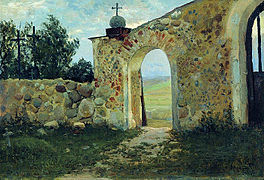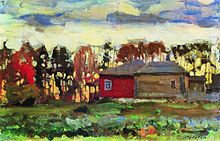Stanisław Żukowski
Stanislav Zhukovsky ( Russian Станислав Юлианович Жуковский Stanislaw Yulianovich Zhukovsky * 25. May 1873 in Jendrichowitschi ( Polish Jędrychowice ; Russian Ендриховичи ), Russian Empire , now Belarus † August, 1944 in Pruszkow ) was a Polish Impressionist and member of the Russian Artists' Association Mir Iskusstva .
Life
Żukowski's mother Maria came from the Warsaw noble family Wierzbicki . On his father's side, he came from a formerly wealthy Polish aristocratic family who took part in the January uprising in 1863 and was expropriated and revoked of their nobility rights due to the subsequent sanctions. He was born in Jendrichowitschi, about 5 km west of Roś on the river of the same name and 15 km northwest of the city of Vaǔkavysk in the former Grodno province , today's Belarusian Oblast Hrodsenskaja Woblasz, as the youngest of three children. The mother taught the children foreign languages, music and encouraged them to draw. From autumn 1880 Żukowski attended the grammar school in Warsaw, after which he was sent to the university in Białystok for further training . It was there that one of his teachers, a graduate of the Stroganov Art School in Moscow, discovered the boy's artistic talent.
After his mother's death, Żukovsky enrolled at the Moscow School of Painting, Sculpture and Architecture in 1892 without the knowledge of his father, who was rejecting his son's artistic training as a Pole in Russia, and also took lessons from Isaak Ilyich Levitan . Among his teachers were Nikolai Alexejewitsch Kassatkin , Konstantin Apollonowitsch Sawizki , Abram Jefimowitsch Archipow and Leonid Ossipowitsch Pasternak . Vasily Dmitrijewitsch Polenow , who was not his teacher, but whose studio he often visited in his spare time , had a decisive influence on Żukowski's education as an artist .
In the 1890s to 1900s he traveled to Central Russia and the Crimea for study purposes, from 1900 to 1901 to the Ukraine and Poland, in 1895, 1901, 1916 to the province of Grodno, and in 1903 Yalta. He spent the summer months in the Moscow suburbs, in Tver and Oryol . To this end, he received a grant from January 1st to early March 1895 “for free accommodation in all cities in the area of the Russian Empire (with permission to draw sketches from nature)”, also for the period from March 6th to September 1st 1895 with a further extension of the period until August 23, 1896, which he spent in the Grodno region, among other places. At exhibitions at his school in 1896 and 1897 he won a small silver medal, and in 1901 a large silver medal for the painting “Mondnacht”, combined with permission to hold a position as a teacher in the public service. In addition, “Moon Night” was included in the Tretyakov Gallery in Moscow . In the year 1897 he married Alexandra Ignatieff (Аляксандрай Ігнацьевай), a friend from college, with whom he remained on friendly terms even after their later separation.
From 1895 Żukowski often took part in exhibitions of the Moscow Society of Art Friends (until 1901), the group Mir Iskusstva (“World of Art”) (1902 to 1903) and “Union of Russian Artists”. One of the first buyers of his pictures was the art collector Pavel Michailowitsch Tretyakov . Żukowski was a celebrated landscape painter associated with Impressionism when he was awarded the title of academic in 1907 and opened his own artist's studio in Moscow , where he taught and promoted many artists until 1917, such as the painter Lyubov Sergejewna Popova and the young Vladimir Mayakovsky . He was regularly awarded for his pictures, for example in 1909 for the painting “Autumn Evening” shown at the International Art Exhibition in Munich with the second prize. In 1912 he traveled through Europe, visiting Switzerland, Germany, France and Italy. In 1916 he married again, his student Sophia (Sosja) Pavlovna Kwasnezkaja (Софя (Зося) Паўлаўна Кваснецкая).
After the October Revolution , Żukovsky tried to rearrange his life, worked in the Moscow Commission for the Protection of Works of Art and Antiques and was a member of the College of Artists at the State Tretyakov Gallery. From 1919 to 1921 he lived in Kirov , worked as an art designer and director at the local theater, organized a solo exhibition in 1920, and returned to Moscow in 1921. As a painter, Żukowski continued to devote himself to landscape painting and the interior of old country estates.
When he realized that his lyrical landscape motifs, mansions and parks did not meet the taste of the “victorious proletariat”, that he was no longer allowed to participate in exhibitions and that this art direction was increasingly criticized in the Soviet press, he left the Soviet Union in 1923 and lived in Warsaw and Krakow , but retained Soviet citizenship for a while. He worked very productively, taught young artists, participated in exhibitions. From 1924 to 1925 his work was shown at a traveling exhibition in the USA and Canada, and in 1929 in Copenhagen. From 1925 to 1939 he took part in exhibitions of the Warsaw Society for the Promotion of Fine Arts and had eight solo exhibitions himself: 1925 at the Charpentier Gallery in Paris, 1929 in Kharkiv , 1931, 1934, 1935, 1937 and 1939 in Warsaw.
He has received prestigious awards and prizes for his paintings and praised in the press as a recognized master of landscape painting. He painted landscapes in Polesia , Belovezhskaya Pushcha , interiors of palaces and country estates. In addition to landscape images in the change of seasons, interiors and views from windows that reveal both part of the interior and the landscape outside are recurring themes.
During the occupation of Poland in World War II , Żukowski stayed in Warsaw. After the Warsaw Uprising , he was interned by the National Socialists with other residents of Warsaw in transit camp 121 near Pruszków, where he died in August 1944 and was buried in a mass grave.
Retrospectives of Żukowski's work were shown in Moscow in 1971, in Leningrad in 1973, in Minsk from 1973 to 1974 and 1995 , in Kiev in 1989, in Mogilev and Polotsk in 1989 . His paintings are in many private collections and museums, including the State Tretyakov Gallery , the Russian Museum , the Museum of Russian Art in Kiev, the National Art Museum of the Republic of Belarus in Minsk, the National Museum in Warsaw , the National Gallery in Krakow and many others.
literature
- Shukowskij, Stanisław Julianowitsch . In: Hans Vollmer (Hrsg.): General lexicon of fine artists from antiquity to the present . Founded by Ulrich Thieme and Felix Becker . tape 30 : Scheffel – Siemerding . EA Seemann, Leipzig 1936, p. 577 .
- A. Jakimowicz: Żukowski, Stanisław . In: Hans Vollmer (Hrsg.): General Lexicon of Fine Artists of the XX. Century. tape 5 : V-Z. Supplements: A-G . EA Seemann, Leipzig 1961, p. 218-219 .
Web links
- Biography Stanisław Żukowski ( page no longer available ) (English), accessed on February 21, 2014.
- Vita Stanisław Żukowski ( page no longer available ), accessed on February 21, 2014
- Elysium Gallery: Zhukovsky Stanislav Yulianovich , accessed February 21, 2014
Individual evidence
- ^ A. Jakimowicz: Żukowski, Stanisław . In: Hans Vollmer (Hrsg.): General Lexicon of Fine Artists of the XX. Century. tape 5 : V-Z. Supplements: A-G . EA Seemann, Leipzig 1961, p. 218-219 .
- ^ Nancy Eickel (Ed.): Russia, The Land, The People: Russian Painting 1850-1910 . Smithsonian Institution, Washington DC 1986, ISBN 0-295-96439-1 .
- ^ Eli Bornstein: The Structurist . tape 15-20 . Wittenborn and Co, 1975, ISSN 0081-6027 , OCLC 2247321 , pp. 80 (English, limited preview in Google Book search).
- ↑ itouchmap.com
- ^ Delia Gaze: Concise dictionary of women artists . Taylor & Francis, Chicago 2001, ISBN 1-57958-335-0 , pp. 539 ( limited preview in Google Book search).
- ↑ Vladimir Kruglov, Vladimir Lenyashin: Russian Impressionism . State Russian Museum / Palace Editions, St. Petersburg 2000, ISBN 0-8109-6714-6 .
| personal data | |
|---|---|
| SURNAME | Żukowski, Stanisław |
| ALTERNATIVE NAMES | Żukowski, Stanisław Julianowitsch (Polish, full name); Жуковский, Станислав Юлианович (Russian); Žukovskij, Stanislav Ûlianovič (scientific transliteration); Zhukovsky, Stanislav (English transcription); Zhukovsky, Stanislaw Julianowitsch; Shukowskij, Stanislaw Julianowitsch (Russian transcription) |
| BRIEF DESCRIPTION | Polish landscape and interior painter |
| DATE OF BIRTH | May 13, 1873 |
| PLACE OF BIRTH | Jendrichowitschi |
| DATE OF DEATH | August 1944 |
| Place of death | Pruszków |







